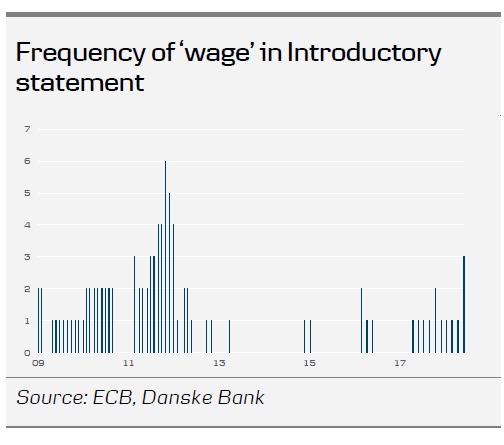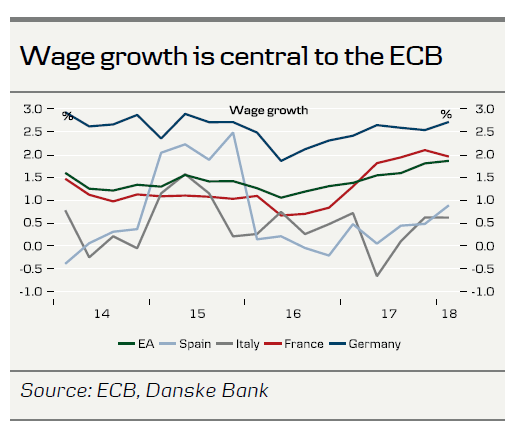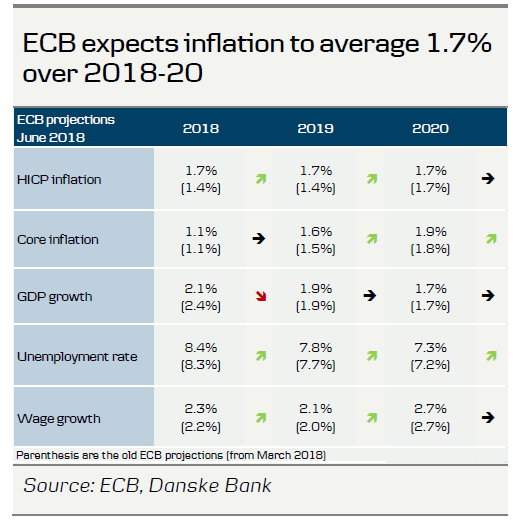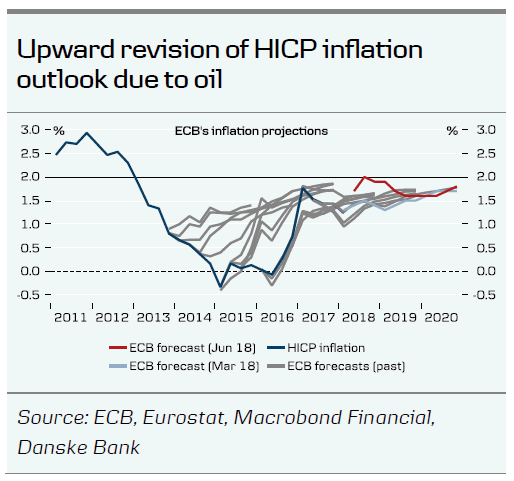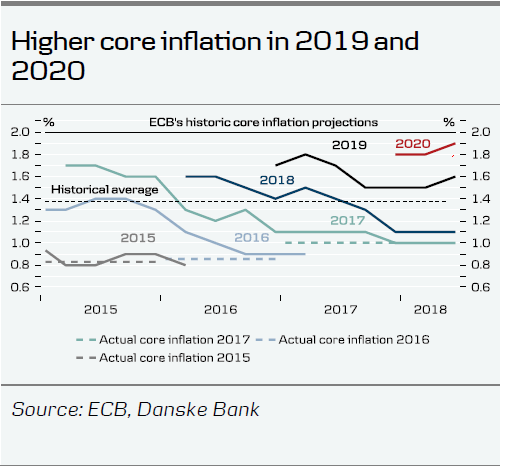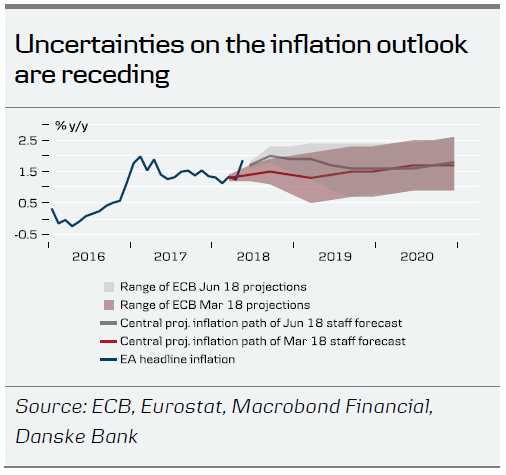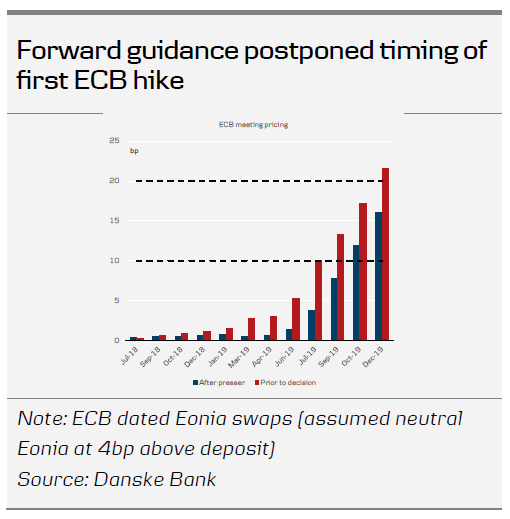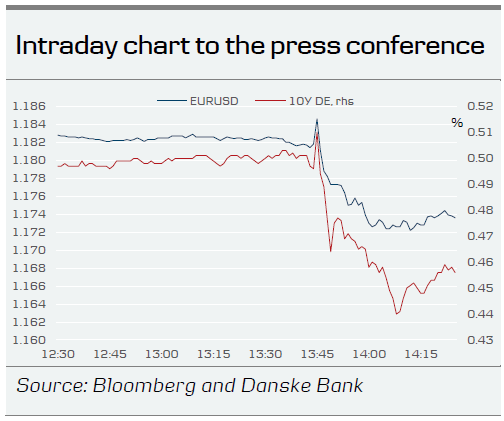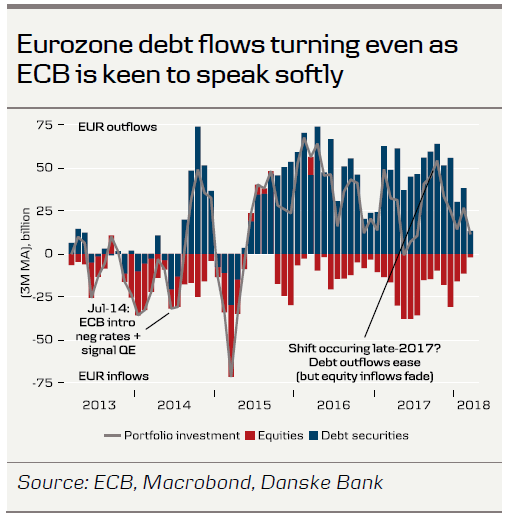- The ECB announced its formal end to QE in June and not in July as we expected. This said, the announcement was as we expected, with the APP Q4 purchase rate of EUR15bn per month; hence, the bond being bought by the end of the year.
- At the same time, the ECB stepped up its forward guidance on rates and said ‘interest rates to remain at their present levels at least through the summer of 2019’. This means that we expect the first ‘live’ meeting to be in September 2019.
- This does not warrant us changing our call on the first ECB rate hike being by 20bp in December 2019.
The ECB ended its APP as it is more confident on the path of inflation towards the aim. It emphasised that the strength of the economy (growth projection of 2.1% this year, still significantly above potential), well-anchored long-term inflation expectations and ‘continued ample degree of monetary accommodation’ are grounds to be confident on the path of inflation towards the 2% target, even after winding down QE purchases.
Mario Draghi struck a dovish tone throughout the press conference, in both the introductory statement and the Q&A. Furthermore, there remain a lot of ‘ifs’ in the statement (i.e. ‘state dependency’), making the further reduction of QE in Q4 and first hike timing still dependent on incoming data on economic/inflation developments.
The stronger guidance on rates followed the speech by Benoît Coeuré back in February, when he said that a ‘shorter purchase horizon could be combined with stronger rate forward guidance so as to mitigate the risk of investors unduly bringing forward their rate expectations’. With the wording ‘the Governing Council expects the key ECB interest rates to remain at their present levels at least through the summer of 2019’, we pay close attention to ‘at least through the summer of 2019’. This suggests the first ‘live’ meeting will be in September 2019, which makes us confident on our call for December 2019 to be the first rate hike. Draghi further said that the ECB did not discuss raising rates.
On inflation, a very interesting comment on the back of Peter Praet’s comments last week was the introductory statement on ‘tightening labour markets and rising wages’. The ECB does indeed seem more confident on wage dynamics – and we take note of the increased usage and focus on ‘wage’ compared with the past five to six years. ‘Wage’ has been mentioned three times now. Draghi even referred to this data as ‘overlooked’.
The ECB also continued to stress the importance of the reinvestment policy as its language on the reinvestment policy was unchanged from last time, i.e. that it will reinvest ‘as long as necessary to maintain favourable liquidity conditions and an ample degree of monetary accommodation’. Overall, the ECB has become more confident on inflation, albeit there are risks to the growth outlook.
We still think the ECB will continue to be dovish, at least in the near term. Overall, markets took the introductory statement and Q&A as dovish (see intraday chart overleaf).
ECB staff projections
The ECB also released new economic forecasts at the meeting.
- Near-term growth outlook revised down but medium-term outlook still solid: Draghi acknowledged that growth has moderated as of late due to a combination of supply-side constraints and temporary factors but stressed that growth remains solid and broad based and he expects it to remain so over the medium term. Reflecting weaker Q1 growth, the ECB lowered the forecast for 2018 from 2.4% to 2.1%, while it left its projections for 2019 and 2020 unchanged at 1.9% and 1.7%, respectively. Risks to the growth outlook were judged to be broadly balanced but uncertainties related to global factors, including the threat of increased protectionism, have become more prominent, while heightened financial market volatility warrants monitoring.
- More optimistic inflation outlook due to energy prices: The ECB expects headline inflation to hover around the current level (1.9% in May) for the remainder of the year. Draghi stressed that underlying inflation pressures remain subdued but, at the same time, the tightening labour market and rising wages mean the uncertainty on the inflation outlook is receding. Hence, the ECB raised its 2018 and 2019 headline inflation forecast from 1.4% to 1.7%, due mainly to the recent increase in oil prices. The revision was partly also a reflection of higher core inflation projections in 2019 and 2020, also on the back of the ECB’s expectations of higher wage growth.
Fixed income
The forward guidance on key interest rates dominated the market reaction in EUR fixed income space despite the announcement of the end of QE. In the press release, the sentence regarding the GC’s expectations of unchanged ECB key interest rates ‘at least through the summer of 2019’ induced a rally in EUR rates. Consequently, marked-based expectations of an ECB hike before or during the summer of 2019 fell significantly.
In contrast to our expectations, the ECB announced an end-date for the APP programme. However, as expected, the outlined taper scheme included a reduced pace of net bond purchases, i.e. down to EUR15bn/month after September 2018 until December 2018, where after the net purchases ends.
Note, in addition to the net bond purchases, expected APP re-investments implied by the estimated redemptions from Oct-18 to Dec-18 also amounts to around EUR45bn. Hence, ECB bond purchases will remain significant also in Q4 18.
In terms of the ECB keeping the front end of the Eonia curve well anchored, the forward guidance on key interest rates will likely keep EUR rates volatilit low and prolong the ‘search for yield environment’ in EUR fixed income space. We continue to be positioned for a tightening of periphery markets (ex. Italy) spreads vs Germany/swaps. Moreover, even though the QE programme ends in 2018, significant reinvestments will be seen in 2019. The first 5 months PSPP reinvestments will be on average EUR 15.4bn a month.
FX: rate guidance keeps EUR/USD <1.20 for extended period
A short-lived knee-jerk move higher in EUR/USD on the QE end-date announcement but this quickly more than reversed as the rate guidance was crucially reinforced and the press briefing kept the dovish tone. Indeed, for the FX market, we stress that it is the new time-dependent rate guidance that is key for the euro: by keeping rate-hike expectations at bay, this effectively keeps the ECB from luring capital flows back to the eurozone near term – a factor we still believe holds EUR upside potential longer term. Despite some evidence of flows turning less EUR negative recently (see chart), with both the Fed (via hikes and balance-sheet reduction) and the Treasury (via issuance) continually adding to the ‘carry appeal’ of USD, this underlines that relative rates will weigh on EUR/USD for some time still and avert a move back to the mid-1.20s any time soon. We still look for the recent range (1.17 +/- a few big figures) to hold near term. It is likely we will need to get much closer to the first rate hike, which now cannot take place before September 2019 at the earliest, before seeing a sustained move above the 1.20 mark (our 12M target remains 1.25).




